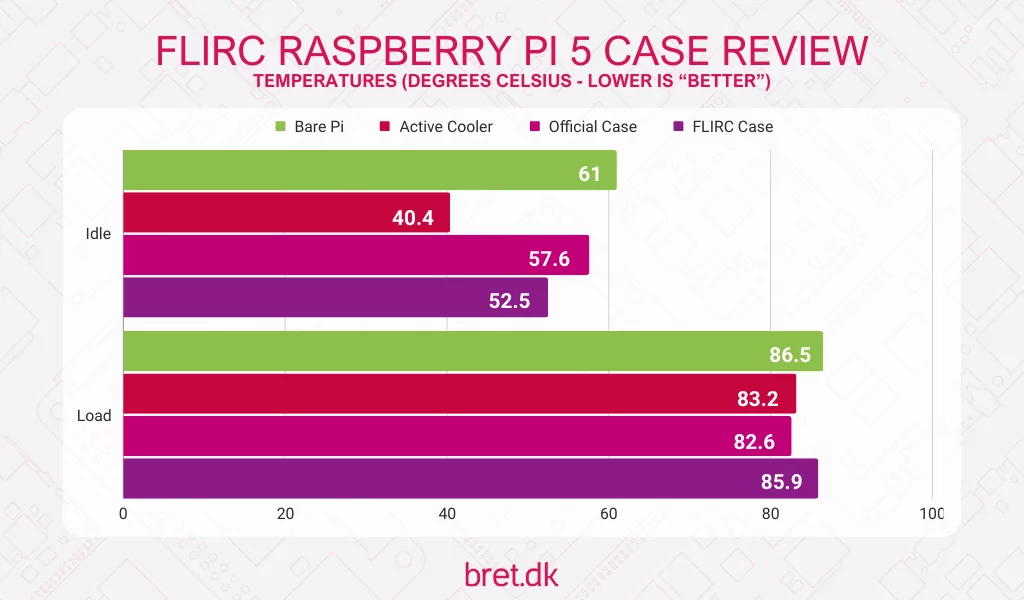Flirc has a long history of creating cases that double as heatsinks/passive coolers for the Raspberry Pi and with the introduction of the Flirc Raspberry Pi 5 Case, this continues.
Table of Contents
Introduction
As I touched on in my full Raspberry Pi 5 review, it’s the most power-hungry and therefore warmest Raspberry Pi to date. Whilst you could run it without any form of cooling and let it thermal throttle under a sustained load, it’s a little more fun to get maximum performance out of your new toy!
The Flirc Raspberry Pi 5 case offers an aluminium chassis that functions as a passive heatsink, with the heat wicked away from the Raspberry Pi 5’s BCM2712 SoC via an included thermal pad that connects to a lowered aluminium piece to carry the heat.

Specifications & Installation
As mentioned, this is an aluminium case, with a plastic cover on the top and bottom. Installation is a breeze, with a single thermal pad to place on the Pi 5’s SoC and then 4 screws to hold everything together. No construction or complicated instructions are needed here!
The case itself weighs 141g and measures 93x66x28mm for those who are interested. This means that it weighs the same as the Flirc Raspberry Pi 4 case which does make me wonder just how well this case is going to hold up given the increased power draw of the Pi 5.
You have full access to the microSD slot as well as the new power button (and a hole for the power LED) and whilst that’s nice, you have no access to the PCIe connection, nor any of the camera ports. You also give up any access to GPIO headers so if you’re looking into this case, you’re going to need to treat it purely as a small computer for compute purposes.
Flirc Raspberry Pi 5 Case Performance and Cooling Efficiency
I’ve tested the FLIRC Pi 5 Case in the same way I did the bare board, the active cooler, and the official Raspberry Pi 5 case in my main Raspberry Pi 5 Review. That’s to say that I am using the performance CPU governor which causes the system to draw around 1 additional watt in power so please consider that when reading the graph!

From this, we can see we’re in a kind of middle ground with the Flirc case. As expected, it doesn’t stop throttling altogether whilst under a sustained load, though it does prolong it for a considerable amount of time. We only see throttling after 4min24s with the Flirc Raspberry Pi 5 case whereas the official Pi 5 case and fan began thermal throttling after just 1min20s.
In addition, I had an infrared thermometer to hand and after the sustained load benchmark, the metal sides of the case were measuring 50.9 degrees Celsius which is rather toasty.
Conclusion
If you’re looking for the best-performing cooling solution then this isn’t it, though that should have been evident given the fact that it’s a passive cooling option. That said, it does handle the increased thermal output of the Raspberry Pi 5 quite well and allows you to push it to its max for over 4 minutes before showing signs of slowing down. In day-to-day usage, that’s going to be plenty.
If you need to push it for longer than that though, you’re likely going to need some form of active cooling and at this point, the official Raspberry Pi 5 Active Cooler is probably your best option in terms of value but if you want it to look nice too, you’re going to need to make a compromise.
Speaking of looks though, the Flirc Raspberry Pi 5 case does look good, though its aesthetic hasn’t changed over the years and why should it, it does the job and everyone knows what to expect.
Would I recommend it? Yup, I would, although only under certain circumstances. For USD 16.95 (+tax/shipping) you’re going to get a case that does a good job of keeping your Pi 5 under control, it looks good, and it’s silent. If you need access to more than just the microSD card, HDMI, and RJ45/USB though, you’re going to have a bad time and need to look elsewhere.
1 comment
Yes it is.
For a good solution : https://www.amazon.fr/gp/product/B0CLTP9N58/ref=ppx_yo_dt_b_search_asin_title?ie=UTF8&psc=1
+ Installing the Pimoroni NVMe Base on Raspberry Pi 5, + 4 M3X 60mm + noctua 5V + crucial PI3 1Go (with this GeeekPi Acrylic case).
Change the pinamori support screws with larger screws and change the acrylic case screws with M3X 55 or 60mm, the PCIe Pipe’ Flat Flex Cable provided by panamori is sufficient for this change. You have a large, compact and well-cooled biscuit. (I changed the fan with a noctua 5v PWM (the cooling is a little lower than with the original noname fan, but it made me happy…)
Quiet and does not exceed 60 degrees in stress test (28 degrees at room temperature).
Best wishes.